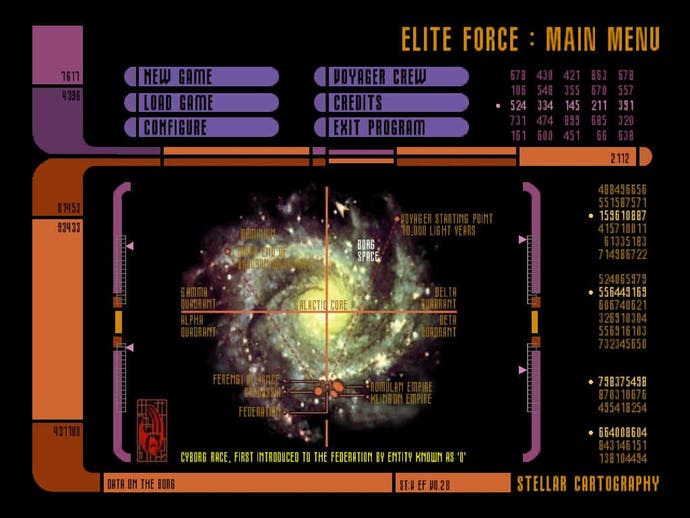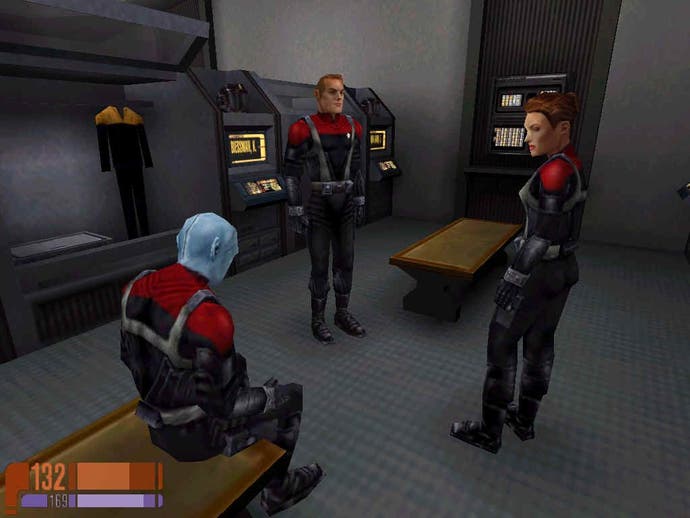Star Trek Voyager : Elite Force
Review - a Star Trek first person shooter that takes no prisoners

Assimilation
The Star Trek Voyager series has become a firm favourite with the Trek fans I know, who have mostly been bred exclusively on the BBC's Next Generation episodes up until now. Who knows quite what the attraction is; perhaps it's the abandonment of the Federation star system security blanket for a more perilous and unpredictable storyline, or perhaps it's the desirability of a larynjectomised Starship captain. Or maybe it's just Borg outcast 7 of 9 and her tight spandex outfit. Actually, I fear it's the latter. But whatever your inclination toward Voyager, you cannot fail to enjoy Elite Force. It's sublime, one of the best single player first person shooters I've played since Half Life. It's a mite short, but what you get is so entertaining it's ultimately forgivable. According to the prologue, you are Ensign Munro, be it Alexander of Alexandria (depending purely upon your gender-bending preference), second in commend of Voyager's elite Hazard Team, which has been formed at the behest of Tuvok to help deal with the most dangerous of missions. Your job is to deal with hazardous away missions and attempts to board the ship. The game is very much like an episode of Voyager. You start out in the thick of the action aboard a Borg cube fighting to save your fellow Hazard Team members, and at a suitable turning point in the action the introductory sequence kicks in, just as though you were in an episode of the series. Of course, the swab of credits smattered around the opening are changed subtly to reflect the game's creators..
Beam me up
All of Voyager's namechecked crew are present, including Captain Janeway, Chakotay, Tuvok, Ensign Kim, Tom Paris, 7 of 9, Nelix and the Doctor along with the usual array of red shirts. All take up their regular roles on the ship, although unfortunately only a few if any have their original voice actors. This wouldn't be such big a deal, but certain characters are very different as a result, particularly sofa-Trekkers' fave 7 of 9, who seems to have suffered an involuntary sex change. Another disappointment is Vulcan super-cool security chap Tuvok, whose usually cunning linguistic repertoire is done no justice here. I don't know what it was, but a lot of the lines seemed uncharacteristic. The characters do actually look very well done in the beautiful Quake III engine, and you can see why a certain female character emerges as Munro's love interest, right down to the way her thighs quiver as she adjusts something on a tricorder. Ahem. When you stop admiring the female player models, you wake up to find yourself a spectator on the bridge during an attack by an unresponsive ship, and watch carefully as Janeway gives the order to fire on it in defence. Its destruction triggers an isodimensional shift that leaves your heavily damaged ship in a starship graveyard, held motionless by a dampening field. Repairs get underway, but scavengers from a nearby ship decide to take the opportunity to loot you for supplies! The first of your missions is to dissuade them, which you do with remarkable pizzazz. From then on, you have to find a way to escape from your starry prison cell by making contact with other races and seeking a peaceful accord. Each mission is laid out for you in the Hazard Team briefing theatre with Tuvok and Chakotay, before tooling up and transporting out - the use of the transporter to move between missions is very adroit, and is a good example of Raven using the Star Trek universe to their advantage.

Set phasers to stun
The away missions vary in structure and intensity. Some of the early ones involve little more than a controlled use of your weaponry. With frequent health and weapon recharge points littered all over the place the general slog through the enemy-infested confines of one early level became very tedious. Thankfully things open up thereafter with some impressive stealth sections like the Scavengers mothership (a bizarre collection of different races, including classic Klingons and Federation crews from the Kirk era no doubt) and some truly intense battles on Borg cubes and elsewhere. Disregarding completely a lot of the ageing concepts of single player FPS titles, Elite Force is consistently exciting, and like a good book the pace and tone of the action varies and the player's emotional attachment to the characters is very strong. One advantage Elite Force does have over a book is the atmosphere created by its soundtrack. The melodious tingling that accompanies the creepy missions and the clattering thunder that flanks your Borg infiltrations is truly inspirational. It ebbs and flows with the mood of the adventure, too. If you've lost crew members after an unsuccessful away mission and morale is low, the music is downbeat and sad, whereas if spirits are riding high, the music echoes the sentiment.

Conflicting views
Just as with the music, your crew very much contribute to the mood of the game. If things haven't gone well, you'll hear them abruptly pause conversations as you reel into the mess hall, shutting you out, and will exchange glares with you as you pass. The AI of your marooned brethren aboard Voyager is very well scripted, although at times it does come apart. Having witnessed the disastrous failure of the "buddy system" in Ion Storm's Daikatana, Raven have decided that the best approach is to have your crewmates follow you by default, with heavy scripting. It works surprisingly well, with none of the caught-on-corners idiocy that dogs many other, similar titles. The only time that the crew comes slightly a cropper is when trundling around the ship on their daily business. The relaxed stroll seen on Star Trek is present, but unfortunately, if you have two crew members walking directly toward one another, they tend to start walking back and forward horizontally across the deck trying to pass one another. The sort of comedy normally reserved for busy city subways on a Friday evening ensues, and not until you butt in do the two part (shouting at you to get out of their way to boot). Regrettably it's not the only flaw that Elite Force has to put up with. The multiplayer mode (launched through a separate executable) is quite clever in execution, using the Federation Holodeck to simulate all sorts of locations, but the gameplay is very slow and unexciting, even with several players on each team. Although there are CTF, Deathmatch and Team DM options (the moniker "Holomatch" is used to denote what you and I know as Deathmatch), there really isn't enough fast paced action and the whole thing smacks of an afterthought. With a little work the multiplay could be fantastic, but Raven's naïve belief that giving everyone the same weapons wouldn't spoil proceedings has been disproved. An emphasis on co-operative multiplay would have been more exciting. Ah well.

Conclusion
Although it has its flaws and takes little more than a couple of days to complete, Elite Force is still an exceptionally enjoyable first person shooter and should not be discounted on the basis of its length. If you fancy a new first person adventure and already own Deus Ex, this is the game to buy.
Eye Candy



